



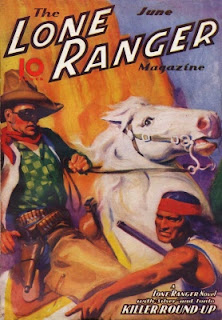 I was never really a huge fan of the Lone Ranger. I watched the Clayton Moore TV show as a kid, and the Filmation cartoon that came on in the late 70s or 80s. The idea of a masked avenger is a cool one, and one that is tried and true in the pages of the pulps. The list of masked vigilantes in comics, film, TV and books is too long to go into here.
I was never really a huge fan of the Lone Ranger. I watched the Clayton Moore TV show as a kid, and the Filmation cartoon that came on in the late 70s or 80s. The idea of a masked avenger is a cool one, and one that is tried and true in the pages of the pulps. The list of masked vigilantes in comics, film, TV and books is too long to go into here. |
| Mrs. M... aka Death |
 |
| Nico has a talk with God. |
| Hoping for a soundtrack CD |
 |
| Tracking the Alien |
Dr. Reid Stanhope, a noted scientist, and Raoul Bornay, a Frenchman of questionable standing, set out upon an expedition to explore the mysteries of ancient Egypt. With their caravan of natives and camels, they pierce the very heart of the great Sahara Desert in their search for the Temple of Death and the sacred Talisman of Set, both considered mythological by everyone except Dr. Stanhope.
After weeks of searching they discover a sarcophagus upon which hieroglyphics read: “He that toucheth or taketh away the Sacred Talisman of Set will bathe his hands in human blood.” Reaching inside the sarcophagus, Stanhope takes out the Sacred Talisman which is also known as the Devil's Trademark – the cloven hoof of Satan.
From the moment the Talisman is released, murder and destruction run rampant. Stanhope is forced to kill Bornay when attacked by him and Bornay's final words are “Don't think you killed a friend – they sent me to get you and the Talisman.” Who “they” are provides the foundation for the story of the rest of the serial, which takes place after Stanhope returned to civilization.
When we pick up the story from there, we see Stanhope telling his niece Ruth he has never had a moment's peace since he hid the Devil's Trademark in a rock vault – he's been haunted by the sudden mysterious appearance of a pair of uncanny looking eyes. While Dr. Stanhope tells the story, a thunderstorm arises and the “eyes” appear outside. He tells Ruth she must get rid of the Talisman as it endangers her life. He takes a dagger from a drawer and says, “Eight other daggers like this are in the hands of eight fellow scientists for safe-keeping. You must have all of them to get the combination of the rock vault, in which is hidden the sacred Talisman.”
When Stanhope receives a telephone call from the mysterious masked Monsieur X, who tells him that his friend, Professor Hubbard, one of the scientists, is dead, Ruth runs across the street to call on Carter Holmes, the criminologist, taking the dagger with her.Stanhope's scream in the distance begins a chain of events that leads to the kidnapping of Ruth by a clan of Devil Worshippers headed by a sorceress named Madame Zora, and a three-way battle between Holmes, the Devil-cult, and an Asian mastermind known as the Octopus to possess the Talisman by collecting the remaining daggers and placing them together in a cliffside vault that will reveal its secret.
An extremely atmospheric serial, heavily influenced by aspects of THE MYSTERIES OF MYRA (the Devil-cult with its crystal ball, and characters who disappear into astral form), and anticipating DRUMS OF FU MANCHU in its noir-ish look, THE TRAIL OF THE OCTOPUS changes location and emphasis many times but remains generally in early pulp/detective/horror mode throughout, with more than the occasional element of the paranormal thrown in to kick the mystery up a notch.
 This serial is being restored by the Serial Squadron and even some missing scenes are being re-filmed with contemporary actors in order to have the story be as complete as possible. Doing this costs money though, and to get this production completed the Serial Squadron has a pledge drive going. What this means is that you pledge beforehand to pay for the DVD upon completion of its production (Spring 2011). This ensures that the costs of restoration and DVD production are covered. The TRAIL OF THE OCTOPUS page explains:
This serial is being restored by the Serial Squadron and even some missing scenes are being re-filmed with contemporary actors in order to have the story be as complete as possible. Doing this costs money though, and to get this production completed the Serial Squadron has a pledge drive going. What this means is that you pledge beforehand to pay for the DVD upon completion of its production (Spring 2011). This ensures that the costs of restoration and DVD production are covered. The TRAIL OF THE OCTOPUS page explains: Pledging does not require immediate payment, however, your pledge is a promise to pay for your DVD set when the DVDs are ready to go to press and should be considered an "order" to be billed to you. You will be sent an email confirming your pledge which only requires response in case of any error in the message, then, if and when the pledge drive reaches its total, an invoice with a PayPal link which will allow you to pay for your DVD set, or information on how to pay using a check or money order by regular mail.
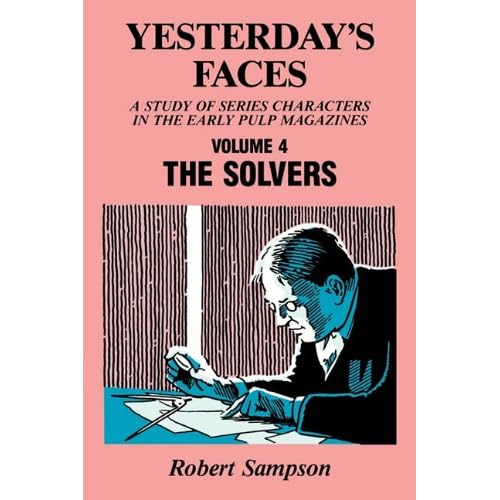


 Darwyn Cooke has a wonderful retro yet modern style to his art and has written some of the great stories of the last few years including the remarkable Justice League: New Frontier. Also he was the artist at the forefront of rebooting Will Eisner's The SPIRIT which has been running for a few years now.
Darwyn Cooke has a wonderful retro yet modern style to his art and has written some of the great stories of the last few years including the remarkable Justice League: New Frontier. Also he was the artist at the forefront of rebooting Will Eisner's The SPIRIT which has been running for a few years now.There is no doubt that Darwyn Cooke and IDW Comics took a bit of a gamble when the decision was made to re-imagine Richard Stark's "Parker" hard-boiled crime thrillers into a series of graphic novels. But man, did that gamble pay off.
Last year, Cooke landed an Eisner for "The Hunter," which he adapted and illustrated, and the 140-page hardcover book also found a home on "The New York Times" bestseller list.
IDW released Parker Book 2: "The Outfit" today and CBR News spoke with the critically acclaimed cartoonist about the title character's latest exploits.
Originally conceived by Donald Westlake, under the pseudonym Richard Stark, Parker made his first appearance in "The Hunter" in 1962. The first novel was adapted into three different movies; "Point Blank" starring Lee Marvin, "Full Contact" with Chow Yun-fat and the Mel Gibson vehicle, "Payback." Parker, an anti-heroic criminal, ultimately appeared in 23 novels, including "The Outfit," which was published in 1963.
Cooke told CBR News that while he made some changes to the original story, every one of those types of choices was a difficult one. But he believed if he stayed true to Parker, a now deceased Westlake would certainly approve. Or at the very least, understand. He also revealed details about the remaining books in the series - "The Score" and "Slayground" - and teased a possible major project for DC Comics. And no, it's not a sequel to "DC: New Frontier."

 When I was in art school I read a 1991 issue of American Cinematographer which had an article on the Lydecker Brothers. Theodore and Howard Lydecker were special effects geniuses who made their names working on Republic Pictures' cliffhanger serials. Some of the iconic imagery that comes to mind are the flying wing used in Dick Tracy (1937) and later reused in The Fighting Devil Dogs (1938). Using life-sized (and bigger) mannequins on string they made a generation of kids believe Captain Marvel and Commando Cody could fly. They created a lot of miniature sets and blew most of them up.
When I was in art school I read a 1991 issue of American Cinematographer which had an article on the Lydecker Brothers. Theodore and Howard Lydecker were special effects geniuses who made their names working on Republic Pictures' cliffhanger serials. Some of the iconic imagery that comes to mind are the flying wing used in Dick Tracy (1937) and later reused in The Fighting Devil Dogs (1938). Using life-sized (and bigger) mannequins on string they made a generation of kids believe Captain Marvel and Commando Cody could fly. They created a lot of miniature sets and blew most of them up. er in their careers they worked in movies such as Sink the Bismark (1960), Fair Wind to Java (1953) and The Flying Tigers (1942) with John Wayne, which was considered for an Academy Award for best special effects, though the Academy board thought the aerial dogfights the Lydeckers created were purely real, causing some disbelief and uproar.
er in their careers they worked in movies such as Sink the Bismark (1960), Fair Wind to Java (1953) and The Flying Tigers (1942) with John Wayne, which was considered for an Academy Award for best special effects, though the Academy board thought the aerial dogfights the Lydeckers created were purely real, causing some disbelief and uproar.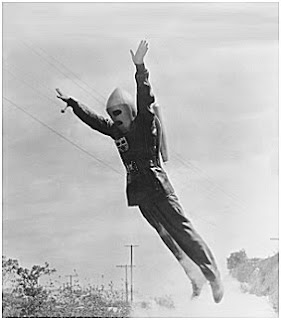 Well now it's time to rejoice.
Well now it's time to rejoice. If you're not sure about the book, check out more online info on the Lydeckers at The Matt Shot blog and at VTTBOTS.com
If you're not sure about the book, check out more online info on the Lydeckers at The Matt Shot blog and at VTTBOTS.com I love pulps. I also love cliffhanger serials. And maybe more than anything, I love behind the scenes info and history about movie and television production. As my poor suffering wife can attest, my bookshelves are jammed with reference books and guides about pulp characters, old movies, radio dramas and T.V. shows.
I love pulps. I also love cliffhanger serials. And maybe more than anything, I love behind the scenes info and history about movie and television production. As my poor suffering wife can attest, my bookshelves are jammed with reference books and guides about pulp characters, old movies, radio dramas and T.V. shows. One of Eric's latest projects (one of many ongoing productions) is the novelization of a lost serial from 1916. THE MYSTERIES OF MYRA is a strange brew of action, intrigue, magic, spiritualism, monsters and zombies. As Eric put it "an X-Files of 1916". Unfortunately quite possibly all prints of MYRA were lost in a warehouse fire. At least at this date it is still considered a lost serial. This is truly unfortunate as from the evidence at hand and eloquently shown in this book, MYRA may be one of the most astoundingly put together serials of the silent and talkie era. From the looks of the stills and behind the scenes photos and info, this was a lavish production with impressive sets and intriguing special effects.
One of Eric's latest projects (one of many ongoing productions) is the novelization of a lost serial from 1916. THE MYSTERIES OF MYRA is a strange brew of action, intrigue, magic, spiritualism, monsters and zombies. As Eric put it "an X-Files of 1916". Unfortunately quite possibly all prints of MYRA were lost in a warehouse fire. At least at this date it is still considered a lost serial. This is truly unfortunate as from the evidence at hand and eloquently shown in this book, MYRA may be one of the most astoundingly put together serials of the silent and talkie era. From the looks of the stills and behind the scenes photos and info, this was a lavish production with impressive sets and intriguing special effects.Tracy Burton ... took on the job of interpreting fuzzy microfilm versions of the newspaper serializations of the story -- virtually all of which were incomplete, damaged, or otherwise messed up, which means after her pass through it and interpretations she was able to make, it took two other guys (me and Dr. Daka) hours and hours to fill in the missing words and correct errors. Daka discovered ... that there were about 5 different versions of the text, also, which all appeared in different newspapers, with different illustrations.

BEWARE THE BLACK ORDER! So comes the warning from the spirit of Myra Maynard's father, who reaches out to her from beyond the grave to warn her of danger from the masters of the occult arts that lurk in the shadows and mark her for murder on her eighteenth birthday. Only the world's first psychic detective, Dr. Payson Alden, and his friend Haji the Brahman mystic, can save clairvoyant Myra from the terrors of The Grand Master of the Order, who tries to claim not only her fortune but her life by means of suicide-inducing spells, invasion of her chamber by spirit assassins, and even reanimation of the dead by a fire elemental. Originally a fifteen-episode serial shot in Ithaca, New York (before Hollywood became the center of American movie-making) in 1916, painstakingly reconstructed from the original screenplay, novelization, and existing stills. Includes background information, behind-the-scenes photos and cast biographies.
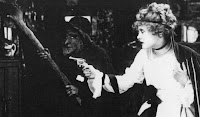
 I occasionally get these ebay email alerts from certain favored sellers. One of them sells older newspaper comics that have been repackaged into books. The pesky thing about the alerts I get on this guy is that sometimes he has really odd items which get my curiosity up in a dander. I've discovered some great graphic artists and obscure comics and just recently discovered the wacky world of English fiction writer Edgar Wallace.
I occasionally get these ebay email alerts from certain favored sellers. One of them sells older newspaper comics that have been repackaged into books. The pesky thing about the alerts I get on this guy is that sometimes he has really odd items which get my curiosity up in a dander. I've discovered some great graphic artists and obscure comics and just recently discovered the wacky world of English fiction writer Edgar Wallace.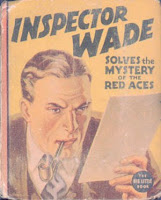 Well back to this ebay seller alert. Recently he had an ad for a newspaper strip called "Inspector Wade, by Edgar Wallace". I recognized the author's name from Kong. Intrigued I looked "Inspector Wade" up. A google search turned up an interesting link which led to a whole bizarre world of which I previously had no knowledge. A German subgenre of crime and mystery movies known as "krimi". Apparently within the krimi genre Edgar Wallace reigned King, with 44 movies adapted from Wallace and his son's books and short stories in a 13 year period. Here are a few krimi movie links for your edification: krimi corner, Cinefear, and Kinwelt has a great listing with descriptions of the 44 Wallace Krimis.
Well back to this ebay seller alert. Recently he had an ad for a newspaper strip called "Inspector Wade, by Edgar Wallace". I recognized the author's name from Kong. Intrigued I looked "Inspector Wade" up. A google search turned up an interesting link which led to a whole bizarre world of which I previously had no knowledge. A German subgenre of crime and mystery movies known as "krimi". Apparently within the krimi genre Edgar Wallace reigned King, with 44 movies adapted from Wallace and his son's books and short stories in a 13 year period. Here are a few krimi movie links for your edification: krimi corner, Cinefear, and Kinwelt has a great listing with descriptions of the 44 Wallace Krimis. ITV, the trailblazing "indie" UK television network created a series based on Wallaces most enduring detective J. G. Reeder, about a bookish, nerdy Gent who puts the fear of God into the gangsters and criminal underworld of London. I've checked out several episodes of this show and have found it to be highly enjoyable.
ITV, the trailblazing "indie" UK television network created a series based on Wallaces most enduring detective J. G. Reeder, about a bookish, nerdy Gent who puts the fear of God into the gangsters and criminal underworld of London. I've checked out several episodes of this show and have found it to be highly enjoyable. classic Wallace, stitching together his favourite themes with enough humour and vigour to keep the reader intrigued till the very end. John Wade is the young Scotland Yard inspector, Lila Smith the beautiful orphan with a mysterious past. There is a a criminal mastermind, a long-standing gang of jewel thieves -- the India-Rubber Men, who wear gasmasks and rubber gloves, and carry gas bombs to stave off pursuit -- and a smattering of Chinese bandits and American mobsters. Through it all runs the Thames, and there is even time for a little excursion out of London to its upper reaches in Oxfordshire. The mixture as before,expertly blended. (description quoted from "Jon" at The Golden Age of Detective Fiction)
classic Wallace, stitching together his favourite themes with enough humour and vigour to keep the reader intrigued till the very end. John Wade is the young Scotland Yard inspector, Lila Smith the beautiful orphan with a mysterious past. There is a a criminal mastermind, a long-standing gang of jewel thieves -- the India-Rubber Men, who wear gasmasks and rubber gloves, and carry gas bombs to stave off pursuit -- and a smattering of Chinese bandits and American mobsters. Through it all runs the Thames, and there is even time for a little excursion out of London to its upper reaches in Oxfordshire. The mixture as before,expertly blended. (description quoted from "Jon" at The Golden Age of Detective Fiction)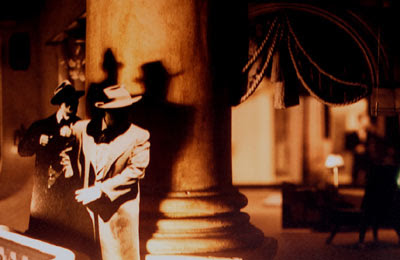 From the Curious Pictures profile on Osbert Parker:
From the Curious Pictures profile on Osbert Parker:Three-time British Academy Award nominated director Osbert Parker is perhaps best-known for his signature style of using cut-out animation mixed with live action to create one-of-a-kind imaginary landscapes within commercials and short films.
For the past three years Parker has been experimenting and crafting two short films that are receiving great acclaim on the international film festival circuit. “Film Noir” was nominated for best short animated film by the British Academy of Film and Television Arts in 2006 and also was nominated for the Palm d'Or at the Cannes Film Festival that year. "Yours Truly," which received the best short animated film award at this year’s British Animation Awards, was also nominated for a BAFTA in 2008 and selected for Sundance. Both films have been screened at the Telluride Film Festival.
He is currently creating the third short in his “Noir” trilogy and developing a mixed-media feature.  I go back to these clips from YOURS TRULY and FILM NOIR on a regular basis. I think they are rich in texture and depth, being pregnant with many possibilities for story threads.
I go back to these clips from YOURS TRULY and FILM NOIR on a regular basis. I think they are rich in texture and depth, being pregnant with many possibilities for story threads.
As an animator who started out in the 70's animating in stop motion, I have a special fondness for the medium and a deep appreciation of artists who utilize it well, such as Mr. Parker does. I do hope that once his third installment is completed that the trilogy will come available on DVD.
Here are the two clips I've probably worn a hole in youtube from over-watching.
 You can now subscribe to The Pulp Reader on Facebook. If it works correctly, you can become a "fan" of the page and you will start getting the latest Pulp Reader articles on your FB wall.
You can now subscribe to The Pulp Reader on Facebook. If it works correctly, you can become a "fan" of the page and you will start getting the latest Pulp Reader articles on your FB wall. What garners this current return is the fact that Black Coat Press has just published a rather amazing book called ARSENE LUPIN VS. COUNTESS CAGLIOSTRO. This collects the Cagliostro cycle (the books COUNTESS CAGLIOSTRO and COUNTESS CAGLIOSTRO'S VENGENCE plus the short story The Queen's Necklace). The first book appeared in English in 1925 and has not been reprinted since, while VENGENCE has not previously been translated to English. Both books are new translations, which may be a good thing as the original THE MEMOIRS OF ARSENE LUPIN translated by Alexander Teixeira de Mattos was not completely faithful and even changed Lupin's original name of Raoul to the terribly mundane "Ralph".
What garners this current return is the fact that Black Coat Press has just published a rather amazing book called ARSENE LUPIN VS. COUNTESS CAGLIOSTRO. This collects the Cagliostro cycle (the books COUNTESS CAGLIOSTRO and COUNTESS CAGLIOSTRO'S VENGENCE plus the short story The Queen's Necklace). The first book appeared in English in 1925 and has not been reprinted since, while VENGENCE has not previously been translated to English. Both books are new translations, which may be a good thing as the original THE MEMOIRS OF ARSENE LUPIN translated by Alexander Teixeira de Mattos was not completely faithful and even changed Lupin's original name of Raoul to the terribly mundane "Ralph". July-December - Lupin is thrown in jail, but continues the fight from his cell. He learns that the Kaiser has called upon Sherlock Holmes to solve the mystery of "813", but the great detective fails to solve the riddle. In August, the Kaiser arranges for Lupin to be freed. Lupin eventually finds the solution, but is outwitted again by Malreich. (Fairness forces one to acknowledge that Lupin solves the mystery in circumstances that may have given him an edge over Holmes.)
July-December - Lupin is thrown in jail, but continues the fight from his cell. He learns that the Kaiser has called upon Sherlock Holmes to solve the mystery of "813", but the great detective fails to solve the riddle. In August, the Kaiser arranges for Lupin to be freed. Lupin eventually finds the solution, but is outwitted again by Malreich. (Fairness forces one to acknowledge that Lupin solves the mystery in circumstances that may have given him an edge over Holmes.)  Okay, is your appetite whetted? Mine is!
Okay, is your appetite whetted? Mine is!